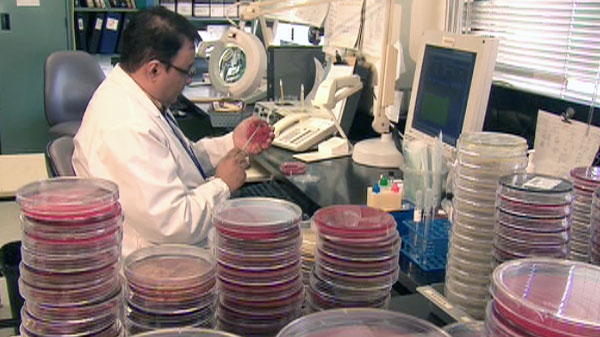A highly worrisome, antibiotic-resistant superbug seems to spreading slowly but steadily across the country.
The Public Health Agency of Canada says eight cases of NDM-1 bacterial infection have now been confirmed, up from three as of late August.
Dr. Michael Mulvey, chief of Antimicrobial Resistance and Nosocomial Infections at the agency, said four of the infected patients were from British Columbia. One was from Alberta. Two others were from Ontario and the last was from Quebec.
At least five of the eight people had travelled to India or Pakistan, where NDM-1 superbug infections were first discovered and where they are becoming more widespread. Four of the patients spent time in hospital, while the fifth had “contact” with the health-care system.
Two of the infected patients have died, although not directly from NDM-1 bacteria. One was a 76-year-old B.C. woman who died of complications from sepsis, while the other patient, from Quebec, had cancer.
The B.C. woman, whose case is described in the journal Emerging Infectious Diseases, had spent more than three months in northern India, where she developed persistent diarrhea and was hospitalized.
Antibiotics failed to improve her condition. She returned to Canada in February and was admitted to hospital in Vancouver, where she died.
According to tests the woman had contracted strains of E. coli and Klebsiella pneumoniae, both of which contained NDM-1.
“She was a very ill person,” Mulvey told The Canadian Press.
NDM-1, whose full name is New Delhi metallo-beta-lactamase-1, is a gene makes the bacteria produce an enzyme that neutralizes the activity of carbapenem antibiotics, which are the class of “last resort” antibiotics reserved for only the most severe infections.
The enzyme has been found in several types of bacteria, so far, primarily in bacteria that cause urinary tract infections and some types of pneumonia.
Bacteria carrying the enzyme were first discovered in hospitals in India and Pakistan. Cases have now been reported in the U.K., Australia, the Netherlands, the United States and Canada, generally among patients who had medical care in India or Pakistan.
In the U.K., some infected patients have passed the infection on to others in hospitals upon their return. The infections have ranged from mild to severe, and some have been fatal.
Mulvey, who is the lead author of the report on the B.C. patient, says he and his team wrote the report to warn the medical community to be on the watch for this kind of infection.
“We’re highlighting that it’s in Canada, that many other countries now are reporting NDM-1 infections,” he said. “Many of them are linked to India, Pakistan, Bangladesh.”
“I guess these are sort of initial cases,” he added. “They haven’t really spread a great deal in any of these countries. But they’re starting to see them sporadically.”
In another report in the journal, Austrian doctors wrote about two patients with NDM-1 infections.
A 30-year-old Austrian man, who was first treated in Pakistan and India for injuries from a motorcycle accident, recovered several months later, after he received a number of treatments.
The second case involved a 14-year-old boy who was admitted to an Austrian hospital in April for abdominal abscesses after his appendix was removed in Kosovo. He had not visited any of the countries known to have NDM-1.
The boy remains in hospital. He had not travelled to any of the countries most affected by NDM-1, suggesting that the superbug may be transmitted within hospitals or within communities outside South Asia.
The authors of the report said the occurrences of NDM-1 infections could lead to the enzyme to jump between different strains of bacteria, creating a more serious threat.
“Immediate action is needed to control the spread of NDM-1 and avoid a worldwide public health problem,” the report said.
With files from The Canadian Press
